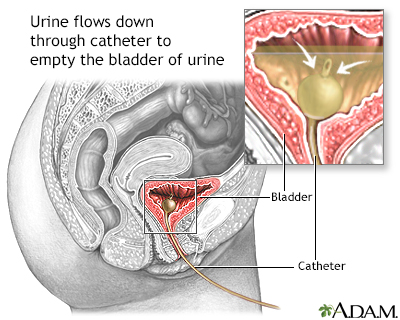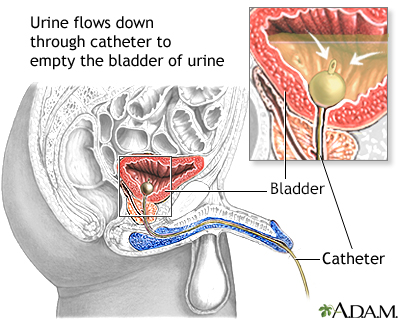Urinary catheters - what to ask your doctor
What to ask your doctor about urinary catheters
You have an indwelling catheter (tube) in your bladder. This means the tube is inside your body. This catheter drains urine from your bladder into a bag outside your body.
Below are some questions you may want to ask your health care provider to help you take care of your catheter.
Images


Questions
How do I take care of the skin around the catheter? How often should I clean the area?
How much water or liquid should I be drinking?
Can I take a shower? How about a bath? Can I swim?
Can I walk around or exercise with the catheter in place?
What supplies do I need to keep in my home to care of my catheter? Where can I get them? How much do they cost?
How often do I need to empty the urine bag? How do I do that? Do I need to wear gloves?
How often do I need to clean the urine bag or catheter? How do I do that?
What do I do if there is blood in my urine? If my urine is cloudy? If my urine has an odor?
If I use a leg bag, how often do I need to change it? How do I empty it when I am in a public bathroom?
Should I switch to a larger bag for nighttime? How do I change this kind of bag?
What do I do if the catheter comes out or off?
What do I do if the catheter stops draining? What if it leaks?
What are the signs that I have an infection?
Related Information
Stress urinary incontinenceUrge incontinence
Urinary incontinence
Urinary incontinence - injectable implant
Urinary incontinence - retropubic suspension
Urinary incontinence - urethral sling procedures
Urinary incontinence - tension-free vaginal tape
Urinary incontinence surgery - female - discharge
When you have urinary incontinence
Indwelling catheter care
Urine drainage bags
Self catheterization - male
Self catheterization - female
Suprapubic catheter care
Prostate resection - minimally invasive - discharge
Transurethral resection of the prostate - discharge
Radical prostatectomy - discharge
References
Boone TB, Stewart JN, Martinez LM. Additional therapies for storage and emptying failure. In: Partin AW, Dmochowski RR, Kavoussi LR, Peters CA, eds. Campbell-Walsh-Wein Urology. 12th ed. Philadelphia, PA: Elsevier; 2021:chap 127.
Vetrosky DT. Urinary bladder catheterization. In: Dehn R, Asprey D, eds. Essential Clinical Procedures. 4th ed. Philadelphia, PA: Elsevier; 2021:chap 30.
BACK TO TOPReview Date: 9/2/2024
Reviewed By: Kelly L. Stratton, MD, FACS, Associate Professor, Department of Urology, University of Oklahoma Health Sciences Center, Oklahoma City, OK. Also reviewed by David C. Dugdale, MD, Medical Director, Brenda Conaway, Editorial Director, and the A.D.A.M. Editorial team.

Health Content Provider
06/01/2025
|
A.D.A.M., Inc. is accredited by URAC, for Health Content Provider (www.urac.org). URAC's accreditation program is an independent audit to verify that A.D.A.M. follows rigorous standards of quality and accountability. A.D.A.M. is among the first to achieve this important distinction for online health information and services. Learn more about A.D.A.M.'s editorial policy, editorial process and privacy policy. A.D.A.M. is also a founding member of Hi-Ethics. This site complied with the HONcode standard for trustworthy health information from 1995 to 2022, after which HON (Health On the Net, a not-for-profit organization that promoted transparent and reliable health information online) was discontinued. |
The information provided herein should not be used during any medical emergency or for the diagnosis or treatment of any medical condition. A licensed medical professional should be consulted for diagnosis and treatment of any and all medical conditions. Links to other sites are provided for information only -- they do not constitute endorsements of those other sites. © 1997- 2025 A.D.A.M., a business unit of Ebix, Inc. Any duplication or distribution of the information contained herein is strictly prohibited.
